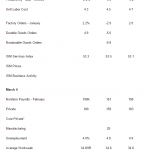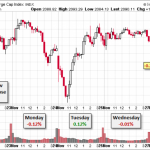Last week, the Federal Open Market Committee (FOMC) decided not to take action on the federal funds rate, leaving it where it has been since last July, in the 5.25%-to-5.5% range. Federal Reserve Chair Jerome Powell did not offer much beyond the usual boilerplate responses, but he did say that it was not likely that the next move would be a rate hike.  Pixabay In the days that followed, several Fed presidents and FOMC members spoke publicly at various events and provided their insights. Two of them, New York Fed President John Williams and Minneapolis Fed President Neel Kashkari, spoke at the Milken Institute Global Conference in Los Angeles this week.Their answers to questions on the trajectory of interest rates and the state of monetary policy may shed some light on where things might be headed. Policy is in a good placeWilliams, who is currently on the FOMC, spoke at the Milken Conference on Monday, saying that things are generally moving in the right direction.“We are seeing a continuation of the process of supply and demand getting back into better balance,” said Williams, and that is critical to getting inflation back to the 2% goal. “Is the stance on monetary policy appropriate for where we are, and I think right now, it is, very much so.”Williams added, “Eventually, we’ll have rate cuts, but right now, I think policy is in a very good place.”Thus, he agreed with the moderator that it is “steady as she goes.” He did not offer an estimate as to when interest-rate cuts might occur, only to say that the committee will rely on the data to guide it and will “hopefully continue to see progress.” The most likely scenarioSpeaking at the conference on Tuesday, Kashkari began his comments by talking about the “puzzling” nature of what happened in 2023, when inflation rates fell rapidly, but the economy did not slow down, as would typically be the case.“It has led me to question: is monetary policy having as much downward pressure on demand as I would have otherwise expected?”He also wondered if the Fed had slammed the brakes hard enough on monetary policy.“Perhaps monetary policy is only putting one foot down on the brakes,” he said, instead of two.As for movement on interest rates, Kashkari said the most likely scenario is that “we stay put for an extended period of time until we get clarity on if disinflation is in fact continuing.”If inflation starts to come back down or if there is some marked weakening in the labor market, that could lead to rate cuts. However, he also said he would need to see multiple reports showing inflation rates dropping before he would be comfortable lowering interest rates.Kashkari did not rule out the possibility of raising rates, although he said that scenario is the least likely and would only be a consideration — from his perspective — if inflation goes higher and stays “entrenched” there for an extended period.“We would do that if we needed to, I think. That’s not my most likely scenario, but I also can’t rule it out.”Later in the conversation, Kashkari discussed inflation, saying that his most likely scenario is that it could go sideways for a while.“Under that scenario, it would lead me, as a policymaker, to say we ought to just sit with interest rates for longer than expected … I think it is much more likely we would just sit here for longer than we expect, or the public expects, right now until we see what effect our monetary policy is having.” How many rate cuts in 2024?Kashkari also responded to a question about the last “dot plot,” or summary of projections, in March, which called for three rate cuts in 2024. Kashkari only jotted down two rate cuts for the year in March, and what he will project in June will depend on the data released between now and then.“It is possible I’d stay at two. It’s possible I would go to one or even zero,” Kashkari said. “We need to look at the constellation of data.”He added that it would not be more than two.Keep in mind that these are only two voices, and other members of the FOMC have also commented since the last meeting, and more will this week. In fact, Fed Vice Chair Philip Jefferson and Boston Fed President Susan Collins were due to speak Wednesday at different events.We will continue to cover what these and other members say about interest rates and monetary policy.More By This Author:Apple Doesn’t Fall: Price Surges On Big Buyback
Pixabay In the days that followed, several Fed presidents and FOMC members spoke publicly at various events and provided their insights. Two of them, New York Fed President John Williams and Minneapolis Fed President Neel Kashkari, spoke at the Milken Institute Global Conference in Los Angeles this week.Their answers to questions on the trajectory of interest rates and the state of monetary policy may shed some light on where things might be headed. Policy is in a good placeWilliams, who is currently on the FOMC, spoke at the Milken Conference on Monday, saying that things are generally moving in the right direction.“We are seeing a continuation of the process of supply and demand getting back into better balance,” said Williams, and that is critical to getting inflation back to the 2% goal. “Is the stance on monetary policy appropriate for where we are, and I think right now, it is, very much so.”Williams added, “Eventually, we’ll have rate cuts, but right now, I think policy is in a very good place.”Thus, he agreed with the moderator that it is “steady as she goes.” He did not offer an estimate as to when interest-rate cuts might occur, only to say that the committee will rely on the data to guide it and will “hopefully continue to see progress.” The most likely scenarioSpeaking at the conference on Tuesday, Kashkari began his comments by talking about the “puzzling” nature of what happened in 2023, when inflation rates fell rapidly, but the economy did not slow down, as would typically be the case.“It has led me to question: is monetary policy having as much downward pressure on demand as I would have otherwise expected?”He also wondered if the Fed had slammed the brakes hard enough on monetary policy.“Perhaps monetary policy is only putting one foot down on the brakes,” he said, instead of two.As for movement on interest rates, Kashkari said the most likely scenario is that “we stay put for an extended period of time until we get clarity on if disinflation is in fact continuing.”If inflation starts to come back down or if there is some marked weakening in the labor market, that could lead to rate cuts. However, he also said he would need to see multiple reports showing inflation rates dropping before he would be comfortable lowering interest rates.Kashkari did not rule out the possibility of raising rates, although he said that scenario is the least likely and would only be a consideration — from his perspective — if inflation goes higher and stays “entrenched” there for an extended period.“We would do that if we needed to, I think. That’s not my most likely scenario, but I also can’t rule it out.”Later in the conversation, Kashkari discussed inflation, saying that his most likely scenario is that it could go sideways for a while.“Under that scenario, it would lead me, as a policymaker, to say we ought to just sit with interest rates for longer than expected … I think it is much more likely we would just sit here for longer than we expect, or the public expects, right now until we see what effect our monetary policy is having.” How many rate cuts in 2024?Kashkari also responded to a question about the last “dot plot,” or summary of projections, in March, which called for three rate cuts in 2024. Kashkari only jotted down two rate cuts for the year in March, and what he will project in June will depend on the data released between now and then.“It is possible I’d stay at two. It’s possible I would go to one or even zero,” Kashkari said. “We need to look at the constellation of data.”He added that it would not be more than two.Keep in mind that these are only two voices, and other members of the FOMC have also commented since the last meeting, and more will this week. In fact, Fed Vice Chair Philip Jefferson and Boston Fed President Susan Collins were due to speak Wednesday at different events.We will continue to cover what these and other members say about interest rates and monetary policy.More By This Author:Apple Doesn’t Fall: Price Surges On Big Buyback
Building Generational Wealth: Two Second-Gen Entrepreneurs Share How To Build A Financial Legacy
Diversifying Your Portfolio With Plant-Based Options







Leave A Comment